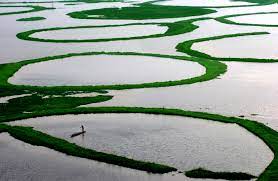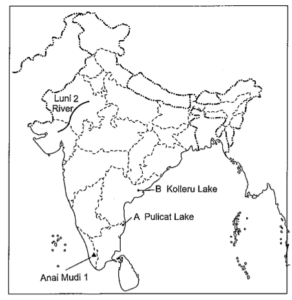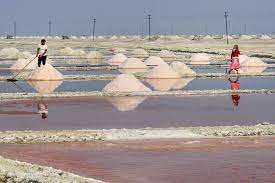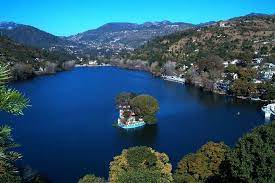India is home to numerous lakes that play vital role in supporting ecosystems, providing water resources, and offering other opportunities. In this article, we will discuss Important Lakes in India highlighting their significance.
Table of Contents
Dal Lake
It is situated in the Kashmir Valley and is surrounded by snow-capped mountains. It serves as a lifeline for the local community, providing livelihoods through tourism and fishing activities.

Lake Pichola
Lake Pichola is a man-made lake located at Udaipur, Rajasthan. It is known for its royal grandeur. Built in the 14th century, it is surrounded by exquisite palaces, including the Lake Palace and the City Palace, which add to its allure.

Vembanad Lake
It is located in the state of Kerala. Vembanad Lake supports a thriving ecosystem, serving as a habitat for diverse flora and fauna. The famous Nehru Trophy Boat Race is held here.

Loktak Lake
It is situated in the northeastern state of Manipur. It is known for its unique floating phumdis (massive vegetation islands), Loktak Lake is not only a scenic wonder but also an ecological hotspot. It is home to the endangered Manipur brow-antlered deer and serves as a vital source of livelihood for local communities engaged in fishing and tourism.

Kolleru Lake
It is located in the state of Andhra Pradesh, and it is one of the largest freshwater lakes in the country. Kolleru Lake is situated between the Krishna and Godavari river basins, primarily in the Krishna and West Godavari districts of Andhra Pradesh. It is located near the Bay of Bengal, making it a coastal lake. The lake covers an approximate area of 245 square kilometers and has varying water levels depending on the monsoon seasons.

Kolleru Lake has been designated as a Ramsar site, which is a recognition of its ecological significance on an international level. As a Ramsar site, it emphasizes the need for conservation and sustainable management of the lake’s ecosystems. Kolleru Lake supports diverse wetland habitats, including marshes, swamps, and submerged vegetation, contributing to the overall ecological balance of the region.
Pulicat Lake
It is the second-largest brackish water lake in India, located on the border of Andhra Pradesh and Tamil Nadu. Pulicat Lake spans an area of approximately 720 square kilometers, with a majority of its area lying in the state of Andhra Pradesh. It is situated along the Coromandel Coast of the Bay of Bengal. The lake is separated from the sea by a long sand spit known as Sriharikota Island.

Pulicat Lake is separated from the Bay of Bengal by the barrier island of Sriharikota, which is known for its spaceport and the Indian Space Research Organisation (ISRO) launch facilities. The presence of Sriharikota Island adds to the scenic beauty and unique geographical features of the region.
Sambhar Lake
It is located in the state of Rajasthan and is the largest saltwater lake in the country. Sambhar Lake is situated in the Thar Desert, approximately 80 kilometers southwest of the capital city of Jaipur. Sambhar Lake is known for its high salinity, making it a salt-producing region. Salt extraction has been a traditional occupation of the local communities around the lake for centuries.

Pushkar Lake
Pushkar Lake is located in the town of Pushkar in Rajasthan, is one of the most sacred and revered lakes in India. It is considered a highly auspicious and holy site. According to Hindu mythology, the lake is believed to have been created by Lord Brahma, the creator of the universe. The annual Pushkar Fair is a major cultural event that takes place around Pushkar Lake.

Lonar Lake
Lonar Lake is a unique and fascinating natural wonder located in the Buldhana district of Maharashtra, India. Lonar Lake is the result of a meteorite impact that occurred around 50,000 years ago. It is one of the few impact craters on Earth formed in basalt rock. The impact of the meteorite created a circular depression, approximately 1.8 kilometers in diameter and 150 meters deep, which gradually filled with water to form the lake we see today.

Chilika Lake
It is located in the state of Odisha and is the largest brackish water lake in Asia and a significant ecological hotspot. Chilika Lake is situated on the eastern coast of India, spread across the districts of Puri, Khurda, and Ganjam in Odisha. It covers an area of approximately 1,100 square kilometers and is separated from the Bay of Bengal by a narrow sandbar known as the Chilika Spit.

Chilika Lake is renowned for its rich biodiversity and is designated as a Ramsar site, recognizing its international importance as a wetland ecosystem. The lake supports diverse habitats, including marshes, mudflats, sandbars, and islands, which provide shelter to numerous resident and migratory bird species. It is home to a wide range of avian fauna, including flamingos, pelicans, herons, and endangered species like the Irrawaddy dolphins.
Chilika Lake is characterized by extensive mangrove forests, which serve as important breeding grounds and nurseries for various marine species.
Nalsarovar lake
Nalsarovar Lake is located in Ahmedabad district of Gujarat. It covers an area of around 120 square kilometers and is a shallow, seasonal lake that expands during the monsoon season.
Nalsarovar Lake is designated as a bird sanctuary and a Ramsar site, highlighting its international importance as a wetland ecosystem. The lake and its surrounding marshes, mudflats, and grasslands provide a diverse habitat for both resident and migratory bird species. It is home to over 250 bird species, including flamingos, pelicans, cranes, and various migratory waterfowl.

Tsomgo Lake
It is a glacial lake situated in the state of Sikkim. Tsomgo Lake is located at an altitude of approximately 3,753 meters in the East Sikkim district of Sikkim. It lies on the ancient trade route between India and Tibet, about 40 kilometers away from the capital city of Gangtok. Tsomgo Lake is known for its breathtaking natural beauty. Tsomgo Lake is believed to have formed due to the melting of glaciers in the region.
Bhimtal Lake
It is located in the town of Bhimtal in the Nainital district of Uttarakhand, Bhimtal Lake is known for its natural beauty and tranquility. Bhimtal Lake is one of the largest lakes in the Kumaon region of Uttarakhand. It covers an area of approximately 47 hectares, with a depth of around 30 meters.
